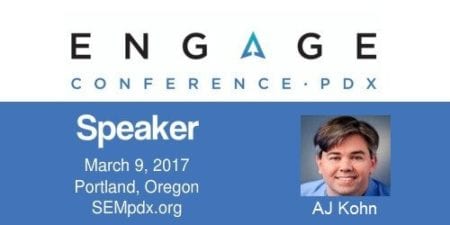A.J. Kohn will be speaking on SEO at the Engage Conference, which will take place March 9, 2017 in Portland. For more information, or to purchase tickets, please click here.

1) Please give us your background and let us know what you do for a living.
I’m Owner of Blind Five Year Old, a digital marketing firm specializing in search. In particular, I work with very large sites.
Originally from Pennsylvania, I received a Marketing degree from George Washington University, spent time in advertising and fund raising before making my way to the Internet. I worked as a marketer for a number of start-ups, rode the end of Web 1.0 out, survived the dot bomb nuclear winter and then discovered paid search. As the Google tax went up I became interested in organic search and the rest, as they say, is history.
2) I’ve worked with clients that have acquired or launched new brands. How would you integrate the SEO efforts for the “new” site into the overall SEO picture.
That’s an interesting question. In fact, I wrote a bit about what I call Acquisition SEO back in January 2016. Now, there are a number of ways to approach the acquisition of a brand or site. Sometimes you’re doing it to take up more shelf space for your business. In these instances, you’ve acquired the brand, in large part, for their SEO value.
So the key is to integrate the new brand into the business without disrupting their SEO. A ‘do no harm’ approach is usually the best practice here. But you can also start to adopt different Title tag strategies to ensure that your business is always standing out. Frequently, similar patterns in Title tags can create a very uniform SERP. A non-standard Title can attract more clicks.
If the acquisition isn’t done for shelf space you do an analysis on which query classes the current site and new site are ranking. The best case scenario is that they’re complementary, meaning each site is attacking different query classes.
When that happens you can go full steam on both sites with aggressive optimization. Other times you have overlap and you then have to determine if you can achieve shelf space or whether you need to cut bait and refocus one of the sites.
Either way, there are plenty of good practices that might be in place on the current site that you can port over to the new site. And often you find something the new site is doing that can help the original site as well. The one thing I generally avoid is creating a massive number of links between the sites. A few are okay but I’m always hesitant to create such a large new footprint of crosslinks.
3) Do you think big sites have an advantage over small sites when it comes to SEO?
Yes. More specifically, sites with large development teams have an advantage over those with small development teams. Technical SEO is still important. Don’t let anyone tell you otherwise. I think of technical SEO as the base of a Maslow’s Hierarchy of SEO. Without that strong base you don’t get as much out of your efforts.
The other reason big sites have an advantage is that they get in front of more people. There’s a bit of a numbers game here. You simply get more chances to hit it big. It’s like having 10 downs instead of 4 in football. Not only that, but every time you get in front of someone you have a chance (usually 1%) of them being a creator. Organic links are easier to get because you have a better chance at finding creators.
Small sites can still do great things and in some ways they can be more nimble (particularly with content) but a big site only needs to hit 25% of their three-point shots. The small sites? They need to have a team of Steph Currys to keep up.
Todd Mintz knows PPC…knows Social Media…knows SEO…knows Blogging…knows Domaining…and knows them all real well. He runs growth marketing for )and is also a Director & Founding Member of SEMpdx: Portland, Oregon’s Search Engine Marketing Association, and he can be found here on Twitter and Facebook.
